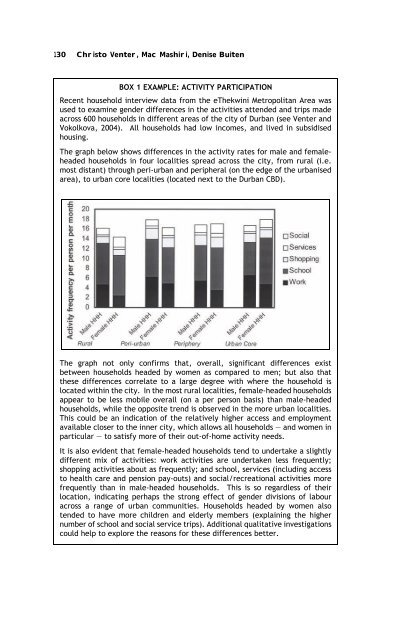Sex, Gender, Becoming - PULP
Sex, Gender, Becoming - PULP
Sex, Gender, Becoming - PULP
You also want an ePaper? Increase the reach of your titles
YUMPU automatically turns print PDFs into web optimized ePapers that Google loves.
130 Christo Venter, Mac Mashiri, Denise Buiten<br />
BOX 1 EXAMPLE: ACTIVITY PARTICIPATION<br />
Recent household interview data from the eThekwini Metropolitan Area was<br />
used to examine gender differences in the activities attended and trips made<br />
across 600 households in different areas of the city of Durban (see Venter and<br />
Vokolkova, 2004). All households had low incomes, and lived in subsidised<br />
housing.<br />
The graph below shows differences in the activity rates for male and femaleheaded<br />
households in four localities spread across the city, from rural (i.e.<br />
most distant) through peri-urban and peripheral (on the edge of the urbanised<br />
area), to urban core localities (located next to the Durban CBD).<br />
The graph not only confirms that, overall, significant differences exist<br />
between households headed by women as compared to men; but also that<br />
these differences correlate to a large degree with where the household is<br />
located within the city. In the most rural localities, female-headed households<br />
appear to be less mobile overall (on a per person basis) than male-headed<br />
households, while the opposite trend is observed in the more urban localities.<br />
This could be an indication of the relatively higher access and employment<br />
available closer to the inner city, which allows all households — and women in<br />
particular — to satisfy more of their out-of-home activity needs.<br />
It is also evident that female-headed households tend to undertake a slightly<br />
different mix of activities: work activities are undertaken less frequently;<br />
shopping activities about as frequently; and school, services (including access<br />
to health care and pension pay-outs) and social/recreational activities more<br />
frequently than in male-headed households. This is so regardless of their<br />
location, indicating perhaps the strong effect of gender divisions of labour<br />
across a range of urban communities. Households headed by women also<br />
tended to have more children and elderly members (explaining the higher<br />
number of school and social service trips). Additional qualitative investigations<br />
could help to explore the reasons for these differences better.
















